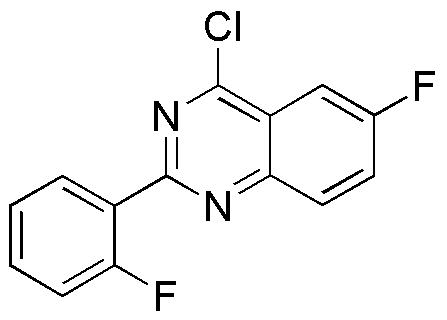4-Chloro-6-fluoro-2-(2-fluorophenyl)quinazoline is widely utilized in research focused on:
- Pharmaceutical Development: This compound serves as a key intermediate in the synthesis of various pharmaceuticals, particularly in developing targeted cancer therapies.
- Biological Research: It is used in studies investigating the inhibition of specific enzymes, helping researchers understand disease mechanisms and potential treatments.
- Material Science: The compound is explored for its properties in creating advanced materials, such as polymers with enhanced thermal stability and chemical resistance.
- Agricultural Chemistry: It has applications in developing agrochemicals, contributing to the formulation of effective pesticides that target specific pests while minimizing environmental impact.
- Diagnostic Tools: This chemical is being researched for its potential use in diagnostic imaging agents, aiding in the early detection of diseases through improved imaging techniques.
Informations générales
Propriétés
Sécurité et réglementation
Applications
4-Chloro-6-fluoro-2-(2-fluorophenyl)quinazoline is widely utilized in research focused on:
- Pharmaceutical Development: This compound serves as a key intermediate in the synthesis of various pharmaceuticals, particularly in developing targeted cancer therapies.
- Biological Research: It is used in studies investigating the inhibition of specific enzymes, helping researchers understand disease mechanisms and potential treatments.
- Material Science: The compound is explored for its properties in creating advanced materials, such as polymers with enhanced thermal stability and chemical resistance.
- Agricultural Chemistry: It has applications in developing agrochemicals, contributing to the formulation of effective pesticides that target specific pests while minimizing environmental impact.
- Diagnostic Tools: This chemical is being researched for its potential use in diagnostic imaging agents, aiding in the early detection of diseases through improved imaging techniques.
Documents
Fiches de données de sécurité (FDS)
La FDS fournit des informations de sécurité complètes sur la manipulation, le stockage et l’élimination du produit.
Spécifications du produit (PS)
Le PS fournit une description complète des propriétés du produit, notamment sa composition chimique, son état physique, sa pureté et les exigences de stockage. Il détaille également les plages de qualité acceptables et les applications prévues du produit.
Certificats d'analyse (COA)
Recherchez des certificats d'analyse (COA) en saisissant le numéro de lot du produit. Les numéros de lot et de lot se trouvent sur l'étiquette d'un produit, après les mots « Lot » ou « Lot de fabrication ».
Numéro de catalogue
Numéro de lot/série
Certificats d'origine (COO)
Ce certificat d'exploitation confirme le pays dans lequel le produit a été fabriqué, et détaille également les matériaux et composants utilisés et s'il est issu de sources naturelles, synthétiques ou autres sources spécifiques. Ce certificat peut être requis pour les douanes, le commerce et la conformité réglementaire.
Numéro de catalogue
Numéro de lot/série
Fiches de données de sécurité (FDS)
La FDS fournit des informations de sécurité complètes sur la manipulation, le stockage et l’élimination du produit.
DownloadSpécifications du produit (PS)
Le PS fournit une description complète des propriétés du produit, notamment sa composition chimique, son état physique, sa pureté et les exigences de stockage. Il détaille également les plages de qualité acceptables et les applications prévues du produit.
DownloadCertificats d'analyse (COA)
Recherchez des certificats d'analyse (COA) en saisissant le numéro de lot du produit. Les numéros de lot et de lot se trouvent sur l'étiquette d'un produit, après les mots « Lot » ou « Lot de fabrication ».
Numéro de catalogue
Numéro de lot/série
Certificats d'origine (COO)
Ce certificat d'exploitation confirme le pays dans lequel le produit a été fabriqué, et détaille également les matériaux et composants utilisés et s'il est issu de sources naturelles, synthétiques ou autres sources spécifiques. Ce certificat peut être requis pour les douanes, le commerce et la conformité réglementaire.


